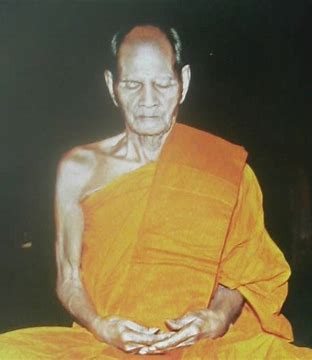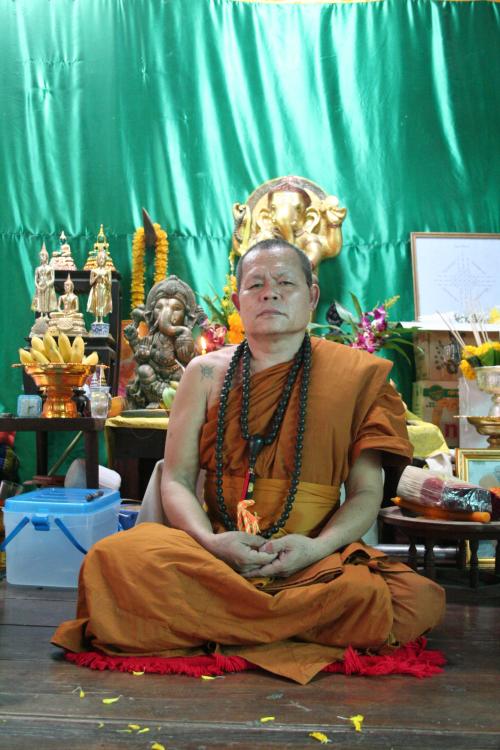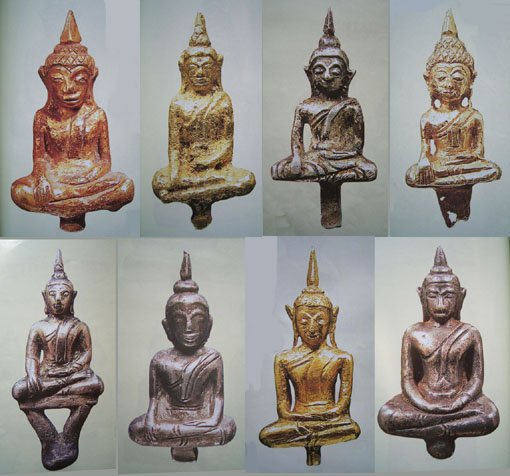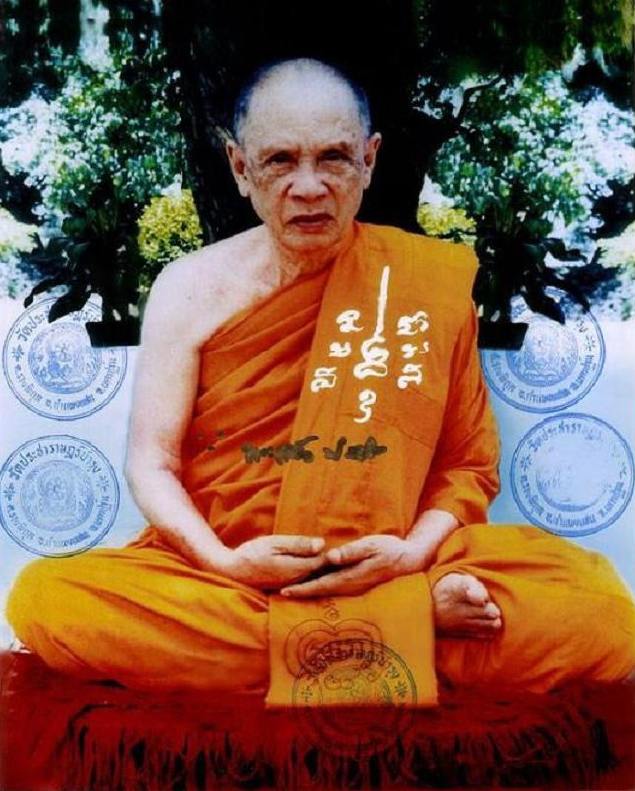Welcome to our store Uncle Chow Amulet Gallery
Archives
Biography – Luang Phor Phrom (Wat Chong Kae)

unclechow.com – Who is the venerable Luang Po Phrom of Wat Chong Kae (Takhli District, Nakhon Sawan, Thailand)?
About LP Phrom – Wat Chong Kae (Nakhon Sawan)
Luang Phor Phrom Tawaro was born on Thursday, April 2nd B.E.2426 (1883) in Baan Prak District, Maharaja, a Subdivision of Ayudhya Province. Son of Mr. and Mrs. Kosalang, he had two sisters (Ms. Loy and Ms. Chab) and one brother (Mr. Plew).
During his childhood, he was educated by Buddhist priests from the temple neighboring his home. After becoming sufficiently literate with the Thai language, he mastered the Khmer Language before officially being ordained as a Buddhist monk at Wat Kean Lai, Ayudhya Province.
Anointed with the name of “Tawaro,” he was in the ordaining ceremony under the authority of Luang Phor Thomya, his mentor. In a short time, he became an advanced practioner of Buddhist meditation, leading to an enlightened and tranquil mind, called “Vipasana Karmatana” in Thai. His disciples said that for many years, Luang Phor Phrom learned and chanted a Pali verse from the text of a sermon and incantation by Ajahn Puang, Luang Phor Dam, and Ajahn Pu Worn.
After Ajahn Pu Worn died, his period of studying supernatural subjects was over. He therefore took to the road as a wondering monk (Tudong) for spiritual advancement. He went deep into the forests, and exchanged knowledge on magic and the supernatural with mentors who were both young and old.
Many of you must be wondering who Luang Phor Phrom’s masters were. Ajahn Puang directly obtained all his knowledge under the monastic coaching of King Taksin’s and King Rama’s master. Ajahn Pu Worn was educated by Luang Pu Nin from Wat Keawpasak in the Province of Phechaboon, Luang Pu Sang from Wat Manicholakan in the Province of Lopaburi, and Ajahn Peng. One of those three instructors was the most important mentor of Phra Buddhajahn Toh, Somdej Wat Rakang.
The Road to Burma
A keen interest in attaining enlightenment drove Luang Phor Phrom to take a merit-making Pilgrimmage to Burma after the end of Buddhist Lent together with Luang Phor Derm of Wat NhongBho. Throughout the journey to Yangon, he went through tremendous forms of suffering and hardship in his encounters with ferocious wild animals, blood-sucking leeches and extreme weather conditions deep in the jungles. Despite these obstacles, he managed to complete his pilgrimage and commited an act of worship at the great Javedagon Pagoda.
Sharpened by his trials and merit-making, he grew wiser. Luang Phor was mindful at all times and refrained from carelessness and monastic indiscretion. He never exploited any of the animals along his journey of merit-making due to his strict adherence of the 227 Precepts, which strictly instructed that a Buddhist monk must avoid committing sins against all life and property. As an example, whenever he meditated, he would always to chant a special mantra to generate a magical seven-layer-gem wall around him for protection. After every meditation session, he would always remove the wall because it might harm animals wandering along if he just left it.
After being a wondering tudong monk for quite awhile, he headed back to Thailand by walking along the bank of the River Mae La Mor in the province of Tak through Kao Chongkae Taklee, a subdivision of the Province of Nakhon Sawan.
Immediately after entering that province, he was greeted by a ferocious rain storm so he went to shelter himself in the caves of Chongkae. He realized that the atmosphere in the caves were so solemn and tranquil that it was ideal for him to conduct his training and meditation. Right then and there, he decided to build a monastery at this place.
During the early stages of establishing the temple, there was nothing, not even a bed. Luang Phor lived in caves high above the ground in difficult conditions. In B.E.2460 (1917), the local residents decided that it was too harsh for Luang Phor to continue living in the caves and invited him to move down to live in the present Wat Kao Chongkae as the monastery abbot.
He agreed and before long, monk residences, a kitchen house, a pavilion for sermons, and a sacred hall with Buddha images were built from donations. He was very popular and respected, so naturally, his disciples started asking Luang Phor to bless and distribute sacred objects – such as Buddha images (Amulets and Buchas), holy coins (Rian) with Luang Phor’s image and loincloths (Payant) from special materials and potent incantations as a way to commemorate their city and as an act of paying homage to Buddha. As expected, all these sacred objects were distributed in a very short time.
He gave these sacred objects out freely to people in need and never asked for anything in return.
After the pilgrimage to the great Javedagon pagoda in Burma, he always fondly remembered how the the gigantic bell rotated like magic. It impressed him greatly. Thus, bells were an important symbol in Luang Phor Phrom’s sacred objects. Many of them were shaped like bells or had images of bells. One example would be an amulet with an image of Luang Phor sitting inside a bell.
He was also inspired to create a burmese style bell which was to be made of brass, gold, various metals and stone. It proved to be an extremely difficult project due to technical reasons. After several failed attempts, Luang Phor gave up.
Later in B.E.2516 (1973), Luang Phor allowed one of Wat Chongkae’s council members to create sacred objects containing special materials by chanting magical mantras and blowing with the mouth to transfer the magic to the objects. At present, the materials put inside these sacred objects have become popular among not only those who adore Luang Phor, but also other Thai people.
Luang Phor stayed at Wat Chongkae for 58 years as an abbot. When he was in charge of the monastery, he promoted Buddhism tirelessly, helped out people in need both medically and financially, and supported the Wat Chongkae School in the temple area as its patron. He died peacefully on Jan 30, B.E.2518 (1975) at Baan Mee Hospital in the province of Lopburi at the age of 91.
His body was put into a crystal coffin. Surprisingly, his body has not deteriorated or decomposed after more than 30 years.
Miracles or Supernatural occurences after Luang Phor’s Death:
- His eyebrows have grown by 5-6 mm
- His eyelashes have grown by 1 cm
- His moustache has grown by 5-6 mm
- His beard has grown by 5-6 mm
- His fingernails have grown by 1 cm
- His toenails have grown by 4-5 mm
These parts are all still growing and require trimming annually. You all are encouraged to witness these evidence yourself.
Luang Phor’s Medicinal Solution
Luang Phor Phrom was very knowledgeable in medicinal herbs. Whenever people living around the area of Wat Chongkae contracted a disease, they would always consult Luang Phor and receive a remedy by taking a medicinal solution combined with magical-formula blowing. Astoundingly, these people would always recover very quickly. There was no question why people all over Thailand went to pay homage to him at Wat Chongkae as well as to get some medicinal treatment from him. In time, the “Tom Ya Boiling Medicinal Solution” ceremony was established and held in April every year.
Luang Phor ordered members of the monastery council to search for herbs from 2 sources:
- Behind Wat Phra Keaw in the province of Ayudhya called “Ting Tang,” especially the herbs growing on a termite hill.
- Koa Kad Region in the province of Nakhon Sawan called “Kra Don Din“ herbs growing on paddy farms as well as “Teen Toa” and “Pla Lai Peark” at Wat Nong Luang in the same province.
The process of making the medicinal solution is as follows:
- Use 3 bricks as foundation.
- Utilize plenty of clay pots to boil the solution.
- From 12:00 am, Luang Phor would meditate and chant a sacred formula into the solution little by little. Luang Phor would sit still in the center of the monastery’s ceremonial hall.
- At 5:09 am, Luang Phor would go down to the place where the solution is being boiled and prayed in deep concentration.
It was said from word of mouth that the all-rounded herbal solution could cure all kinds of ailments. You just had to chant a formula before swallowing the solution. Moreover, if any person uses the solution as a shampoo or for bathing, he or she would be protected and invulnerable to weapons. It was a medicine superior to all.
Most of the time, Luang Phor was a man a few words. He seldom spoke and rarely socialized due to his dedication to meditation practice. On one hand, he was the incomparable meditation practitioner full of supernatural powers who brought benefits to people who had faith in him. On the other, he was the best listener with a good ear and a kind heart. Therefore, as a matter of principal, he would always speak out when something critical is going to occur in the near future. It was clairvoyance and he was often called a prophet. He was known as Luang Phor Pak Phra Roung The Luang Phor with miraculous Power of Mouth.
The following stories are testimonials to the above:
Ms. Kleawpan Tangsuwan, a food vender at the train station in Wat Chongkae, went to make some merit at the temple so often that she became very familiar with Luang Phor. One day, Luang Phor greeted her and said, “Kleaw, you’re going to be a millionaire soon.” She replied, “I don’t think that’s possible, but just richer than what I have now would be perfect.” “OK! Just richer as you wish.” he said back. Not long after the conversation, she became richer and richer. Eventally, she donated a big lump sum to the temple, and built a hall for sermons as a tribute to Luang Phor.
There was a member of the monastery council who embezzled money from donations and monastery funds. When this was discovered, Luang Phor said, “If he did take money from the monastery, he will die.” True enough, he passed away shortly after Luang Phor said this.
Sometimes, Luang Phor liked to give out loincloths (Payant) to those who came to pay homage to him. These loincloths would be blessed by magical-formula blowing. Whoever took these loincloths home would become magnificently fortunate and affluent. However, these loincloths were considered rare, so one monk in the temple went and bought dozens of loincloths at the marketplace, and sold them without Luang Phor’s permission. When Luang Phor recognized this deceitful business, he said to the monk “Are you out of your mind?” Supernaturally, the monk came undone and went unnoticed since then.
Dr. Somsook Khonguria, one of the disciples, recounted that one day, he asked, “Luang Phor! Whenever you speak out, it’s like cursing. You say things that are unexpected, but it will always come true in an astonishing way.” He asked further, “Isn’t that a sin against living things which is forbidden in the rules for monks?” Absolutely not a curse, but a blessing instead.” replied Luang Phor. Dr. Somsook then realized spontaneously that it was very true that Luang Phor prophesized critical events and blessed people on purpose. When Luang Phor foresaw that something wrong was going to take place, he was likely to present people with an apocalyptic vision of the future as a warning for them to avoid making the wrong decisions and from committing sins.
In B.E.2515 (1972), an Ajahn (Brahmin priest) brought some sacred objects to ask Luang Phor to bless, but unfortunately, Luang Phor was very unhappy and annoyed by his request. “You are very annoying. Are you nuts?” It was widely known that if Luang Phor spoke out and warned, it would come true. The Ajahn was filled with fear and doom that he would go crazy and could think of nothing else. He went to consult Dr.Somsook, one of Luang Phor’s favourite disciples on what to do. After realizing the Ajahn’s fear of going crazy, he advised the Ajahn to make Luang Phor some drinks. He then brought drinks for Luang Phor as well as the cats and dogs living in the temple area. Dr.Somsook then urged Luang Phor to look at Ajahn, and praised him in recognition of his good deed. “He is such a good man, said Dr.Somsook to Luang Phor. “Right! Right! He is a good person indeed. Not crazy.” answered Luang Phor. Right then the Ajahn felt a warmth of relief. Not only did the Ajahn become more prudent and discreet in terms of what he bore in his mind, he also realized the importance of kindness and doing good things for others.
Phra Saman Kitivutho, a Buddhist monk currently living at Wat Chongkae, described astoundingly that Luang Phor was able to walk on the surface of a pond. It was witnessed by him and several children playing around the area.
One day Luang Phor went to the pond to get water to bathe himself. He sat on the edge of a wooden jetty with his lower garments draped over his shoulder and a basin to dig up water to cleanse himself. As he immersed his feet into the pond, a strong wind blew the basin very far away. Luang Phor asked the children who were also bathing to get the basin, but it was too far away to grab. Luang Phor then told the children that he would pick it up himself. Luang Phor then stood up and walked on the surface of the pond to pick up the basin which had blown far away. All the children witnessed that and was shocked and flabbergasted. “It’s hard to believe that the impossible was happening, but there were plenty of eyewitnesses. You can go and ask them yourself.”
Luang Phor Phrom enjoyed watching the Khon, a traditional drama and dance performed by dancers wearing masks depicting the story of Ramayana. He set up a Khon troupe to give practice to people who were interested. Kru Plai and Kru Yearn were his expertise in Khon. In fact, Luang Phor Phrom’s Khon troup still performs live today.
Those who have faith in Luang Phor Phrom pays homage to his body in Wat Chongkae’s sermon hall. They pray and make wishes for their lives to improve. Good things always happen to those who do good deeds.
Luang Phor had a specific procedure when creating sacred objects. He would start the procedure just after 12:00 am by placing the objects into metal bowls and then lighting a victory candle and dripping the melting wax into the bowls. As he drips the wax, he would simultaneously focus with deep concentration and chant magical mantras continuously until the end of the ceremony. Then he would sprinkle sacred water on them to ensure their efficacy as objects that will bring people luck and protection. Thus, if some of Luang Phor’s sacred objects appear to have physical defects, it might be because it was handled by Luang Phor’s sacred hands.


